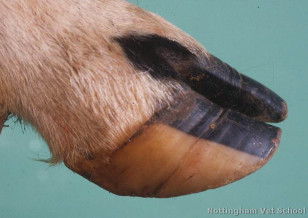
A cow’s hoof (School of Veterinary Medicine and Science University of Nottingham via Creative Commons)
Early ancestors of cows and pigs had legs with five toes, just like humans. So what changed?
Scientists at the University of Basel in Switzerland believe they have the answer. They’ve identified a gene regulatory switch that played an important role in the evolutionary changes in the limbs of members of a group of large mammals called ungulates.
According to the fossil record, it turns out that early ancestors of the animals in the ungulate group, originally had legs with five toes instead of two twos or cloven hooves.
But, as the animals evolved so did their limb structure, these evolutionary changes provided these animals with better traction that allowed each species, with their own specific and unique body structures, to properly and easily traverse a variety of terrain.

Artist’s impression of the preliminary design of ESO’s European Extremely Large Telescope which is being built atop Cerro Armazones in Chile’s Atacama Desert. (ESO/L. Calçada)
Scientists are planning to blow up a portion of a mountain top in the Chilean Andes in the name of science.
The European Southern Observatory’s plans for its new European Extremely Large Telescope (E-ELT) require a large and level area upon which to build it.
Officials say the blast, which ESO is referring to as a “ground-breaking” will take place Thursday, June 19 between 1630 and 1830 UTC. And you’ll be able to watch the mountain top being blown away live via webcast.
The ESO says they plan to lop off about 40 meters from the top of Cerro Armazones Mountain in Northern Chile. Nearly a million tonnes of rock will are expected to be blown off in the blast.
The E-ELT is expected to catch 15 times more light than any current optical telescope and produce images that will even be 16 times clearer than what is captured by the Hubble Space Telescope.
The ESO hopes to have its new Extremely Large Telescope up and running by the 2020s.
Young men who watch a lot of violence on TV show signs of less mature brain development.
A study from the Indiana University School of Medicine also found these men to have poorer executive functioning—mental processes that help us problem-solve, reason, and make decisions—than those exposed to little or no violence from TV and movies.
To reach their findings the researchers, used psychological testing and MRI’s to measure the brain volume and mental abilities of 65 healthy young men between the ages of 18 and 29.
The guys all had normal IQ’s and were specifically chosen for experimentation because didn’t regularly play video games.

A British Airways Concorde en route to London from New York in June 2000. (Aero Icarus via Flickr/Creative Commons)
NASA is stepping in to speed the return of supersonic passenger travel.
When the last Concorde flew its last flight about 11 years ago, airline passengers were left without a way of traveling faster than the speed of sound.
The US space agency has been working on ways to help overcome one of the huge obstacles in bringing back supersonic travel; the sonic boom that’s produced when an aircraft flies faster than the speed of sound.
NASA researchers this week will be briefing members of the aviation industry on the work they’ve been doing to reduce the sonic boom.
The space agency believes that research into supersonic flight has produced results that could soon make it possible to design and produce low-boom supersonic jets.






















Comments are closed.